Click on images to enlarge
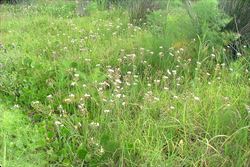
infestation (Photo: Sheldon Navie)
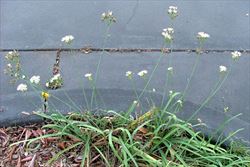
habit (Photo: Sheldon Navie)
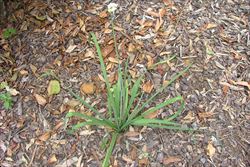
habit (Photo: Sheldon Navie)
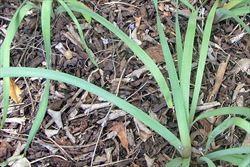
the strap-like, bluish-green, leaves (Photo: Sheldon Navie)
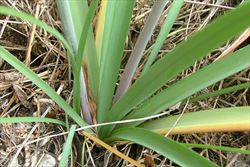
close-up of base of stems and leaves (Photo: Sheldon Navie)
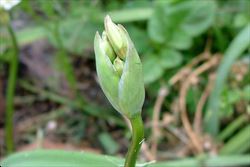
young flower cluster, enclosed in a pair of papery bracts (Photo: Sheldon Navie)
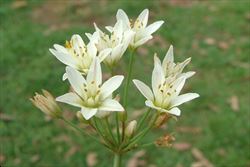
close-up of flowers (Photo: Sheldon Navie)
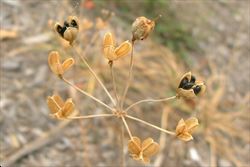
mature fruit with black seeds (Photo: Sheldon Navie)
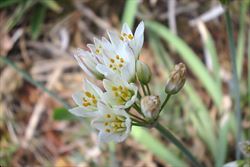
flower cluster, with pale pinkish markings down the centre of some of the 'petals' (Photo: Sheldon Navie)
Scientific Name
Nothoscordum borbonicum Kunth
Synonyms
Allium fragrans Vent. (misapplied)Nothoscordum fragrans (Vent.) Kunth (misapplied)Nothoscordum gracile (Ait.) Stearn (misapplied)Nothoscordum inodorum (Ait.) G. Nicholson (misapplied)
Family
Alliaceae (Queensland, New South Wales, the ACT and Western Australia)Liliaceae (Victoria, South Australia and Tasmania)
Common Names
false onion weed, fragrant false garlic, fragrant false-garlic, fragrant onion, Gowie's curse, Gowie weed, honeybells, oleanderleaf nothoscordum, slender false garlic, sweet garlic, wild onion
Origin
Native to southern Mexico, Central America (i.e. Costa Rica, Guatemala, Honduras and Panama) and South America (i.e. Brazil, Peru, Argentina, Chile, Paraguay and Uruguay).
Naturalised Distribution
This widely naturalised introduced species is mostly found in the southern and eastern parts of Australia, particularly around populated areas. It is most common in south-eastern Queensland, eastern New South Wales, the ACT, Victoria and south-eastern South Australia. Occasionally naturalised in south-western Western Australia, in inland southern and central Queensland, in inland New South Wales and in Tasmania. It has also been naturalised on Lord Howe Island and Norfolk Island, though it is thought to have been eradicated from Lord Howe Island.
Widely naturalised in other temperate regions of the world, including in Europe, southern Africa and the USA.
Habitat
A common weed of gardens, footpaths, lawns, waste areas, disturbed sites, roadsides, pastures, crops and wetlands in the temperate and sub-tropical regions of Australia.
Habit
A long-lived (i.e. perennial) onion-like plant with upright (i.e. erect) stems usually growing 15-60 cm tall, but occasionally reaching up to 1 m in height.
Distinguishing Features
- a long-lived, bulbous, onion-like plant with narrow, strap-like (i.e. flattened), leaves.
- these leaves are only produced in loose clusters at the base of the plant.
- its whitish-coloured flowers are borne in dense clusters at the top of long, upright, stalks.
- its fruit are small capsules with three compartments.
Seedling
The flowering stems (i.e. scapes) are slender, cylindrical, and green in colour.
The leaves are narrow and strap-like (15-60 cm long and 2-10 mm wide) with papery sheaths at the base and only a faint onion-like smell. They are clustered together, in a group of 2-10, at the base of the plant and are usually drooping in nature. These leaves are hairless (i.e. glabrous), with entire margins and rounded tips (i.e. obtuse apices).
Stems and Leaves
The small underground bulbs are egg-shaped (i.e. ovoid) and white in colour (15-25 mm in size). Mature plants have a large main bulb with many smaller 'bulblets' clustered around its base. Each year these bulbs give rise to several basal leaves and an upright (i.e. erect), cylindrical, flowering stem.
The leaves are narrow (i.e. linear), strap-like (i.e. flattened) and 15-60 cm x 4-10 mm in size. They possess papery sheaths at the base and give off only a faint, onion-like, smell.
Flowers and Fruit
The fragrant white flowers (1-1.5 cm long) are borne in clusters of 8-20 at the top of an upright (i.e. erect) stalk 40-100 cm long. Individual flowers are borne on stalks (i.e. pedicels) 1-4.5 cm long that emanate from the same point (i.e. in an umbel). Young flower clusters are enclosed in two papery bracts (i.e. spathes) 6-15 mm long. Each flower has six 'petals' (i.e. perianth segments or tepals) 8-15 mm long that are white with pale green to pinkish or brownish central markings. They also have six yellow stamens (7-8 mm long) and an ovary topped with a whitish style and stigma. Flowering occurs in mostly during spring and summer (i.e. from September to January).
The small capsules (5-8 mm long) turn from green to pale brown in colour as they mature. They have three compartments, each containing 4-12 seeds. These seeds are black, strongly angled and about 2 mm long.
Reproduction and Dispersal
This species reproduces by seed and also vegetatively via underground bulbs. The egg-shaped (i.e. ovoid) bulbs are white (1.5-2.5 cm long) and mature plants have a large main bulb with many smaller bulblets clustered around it.
Seeds can be dispersed by wind and water and in dumped garden waste, while the bulbs and bulblets are spread by the movement of contaminated soil.
Environmental Impact
False onion weed (Nothoscordum borbonicum) is regarded as an environmental weed in Victoria, South Australia, New South Wales and Western Australia. While this species is common as a garden weed in large parts of southern and eastern Australia, it is mainly a concern as an environmental weed in coastal districts in temperate regions. It has spread from gardens into riparian areas, wetlands, estuarine areas and coastal sand dunes.
False onion weed (Nothoscordum borbonicum) appears on several environmental weed lists in the wider Sydney and Blue Mountains region, where it invades river edges and estuarine flats. It has been recorded in numerous conservation areas in this region (i.e. Mount Gibraltar Reserve, McKay Reserve, Lane Cove National Park, Cooper Park, Deepwater Reserve and Bungan Beach Reserve) and also in Montagu Island Nature Reserve, off the southern coast of New South Wales.
This species is also a common environmental weed of the Adelaide region, where it occurs on plains, along creek and on hillsides. For example, it is listed as an invasive plant in bushland in the Adelaide Hills Council District and has been recorded as a weed in the Murtho Park wetland complex and in Innes National Park in South Australia.
In Victoria, false onion weed (Nothoscordum borbonicum) has been recorded in Yarra Bend Park in suburban Melbourne, and is listed as an environmental weed in the Goulburn Broken Catchment. It is also an occasional weed of riparian vegetation in Brisbane area and the Burnett River Catchment in south-eastern Queensland, and is found in disturbed bushland between Perth and Albany in south-western Western Australia.
Other Impacts
This species is also a common and very difficult to eradicate weed of gardens.
Legislation
Not declared or considered noxious by any state government authorities.
Similar Species
False onion weed (Nothoscordum borbonicum) is similar to three-cornered garlic (Allium triquetrum), onion weed (Asphodelus fistulosus) and dune onion weed (Trachyandra divaricata). These species can be distinguished by the following differences:
- false onion weed (Nothoscordum borbonicum) has flattened, strap-like, leaves and produces upright flowers that are borne in clusters at the top of its thin, cylindrical, unbranched stems. These flowers sometimes have a reddish or greenish-coloured stripe running down the outside of each 'petal' (i.e. perianth segment).
- three-cornered garlic (Allium triquetrum) has flattened, strap-like, leaves (with a 'keel' running down one side) and produces drooping flowers that are borne in small, loose clusters at the top of its three-angled (i.e. triquetrous), unbranched stems. These flowers have a green stripe running down the middle of each 'petal' (i.e. perianth segment).
- onion weed (Asphodelus fistulosus) has cylindrical, hollow, leaves and produces flowers that are borne along its thin, cylindrical, few-branched stems. These flowers have a reddish stripe running down the middle of each 'petal' (i.e. perianth segment).
- dune onion weed (Trachyandra divaricata) has flattened, hollow, leaves and produces flowers that are borne along its cylindrical, much-branched stems. These flowers have a reddish stripe running down the middle of each 'petal' (i.e. perianth segment).

